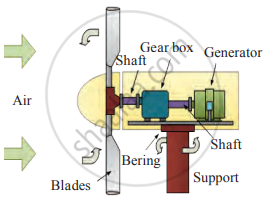Advertisements
Advertisements
प्रश्न
What is hydroelectricity? Explain the basic principle of generation of hydroelectricity with the help of a labelled diagram.
उत्तर
Hydroelectricity is the product of a process by which mechanical energy from the flow of water is used to generate electricity.
It works on the principle of conversion of mechanical energy into electrical energy. Mechanical energy from the flow of water is used to rotate turbines, which are connected to a dynamo that generates electricity.

APPEARS IN
संबंधित प्रश्न
There are four fuels which all contain only carbon and hydrogen. The fuel having highest calorific value will be one which has:
(a) more of carbon but less of hydrogen
(b) less of carbon but more of hydrogen
(c) equal proportions of carbon and hydrogen
(d) less of carbon as well as less of hydrogen
Flowing water can rotate a turbine. Which type of energy is used up by the turbine?
State two advantages of producing hydroelectricity.
What is common between the sun and a hydrogen bomb?
Describe how hydro-energy can be converted into electrical energy.
Give scientific reason
It is possible to produce energy from mW to MW using solar photovoltaic cells.
In a windmill, the rotating blades drive the turbine and the turbine in turn drives the generator to generate electricity.
Observe the given diagram and answer the questions.

- Which type of energy is generated?
- This power station depends on which factors?
- Is it environment friendly?
Choose the correct statement.
In a hydroelectric power plant more electrical power can be generated if water falls from a greater height because
